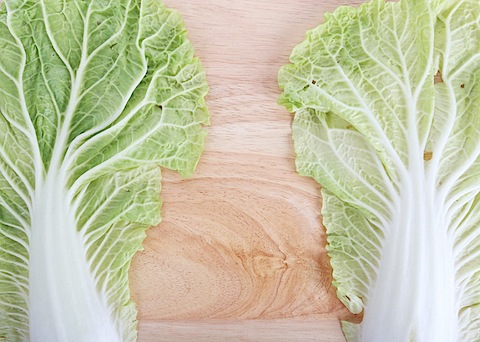June 6th 2015

Mainstream medicine's cancer treatments of radiation and chemotherapy are far from a cure.
In fact, they make cancer more deadly. But new research shows some common
vegetables may be more effective in battling cancer.
Why? The answer has to do with cancer stem cells (CSCs) that chemo and radiation can't touch.
In a study published in the journal Cancer, UCLA researchers showed that radiation actually makes breast cancer cells MORE malignant.[i] They found that radiation kills about half of the tumor cells treated.
But radiation also transforms other cells into "induced breast cancer stem cells." Though cancer stem cells make up less than 5 percent of a tumor, they can regenerate the original tumor. In fact, these new stem cells are up to 30 times more likely to form tumors compared to cancer cells that didn't get radiation . CSCs can also migrate through blood vessels spreading cancer to secondary locations.
Chemo works the same way. It kills only the less harmful cancer cells . The cells that are left are more the lethal CSCs that are resistant to traditional treatments.
Now researchers from South Dakota State University have found that a compound in cruciferous vegetables like broccoli, cabbage, and cauliflower may target those cancer stem cells. [ii] In fact, it may help prevent the recurrence and spread of some cancers.
The compound is called phenethyl isothiocyanate (PEITC). When the researchers added PEITC to a Petri dish with human cervical cancer stem cells about 75 percent of the stem cells died within 24 hours.
PEITC is found in cruciferous vegetables. Studies show it has anti-inflammatory powers. It's also been shown to have chemopreventive activity against a range of cancers including colon, prostate, breast, cervical, ovarian, and pancreatic. It's currently in clinical trials for lung cancer.
The South Dakota researchers found that PEITC slowed the formation of cervical cancer stem cells in a dose-dependent manner. The researchers also found that PEITC significantly reduced the proliferation of both cervical cancer cells and stem cells. In fact, it worked comparably to salinomycin, a chemo drug, but without the toxic side effects.
In addition, the effects of PEITC were significantly better in abrogating cervical cancer stem cell proliferation than paclitaxel , another toxic chemo drug.
In mice, the researchers also found that PEITC lowered the average number and size of tumors.
The researchers noted that "it is becoming increasingly evident that cancer treatment that fails to eliminate CSCs allows relapse of the tumor."
They concluded that "importantly, PEITC is anti-proliferative in both [cervical] cancer cells and [cervical cancer stem cells], suggesting that it may contribute to eradication of cancer more efficiently than compounds targeting either CSCs or regular cancer cells alone."
You don't have to wait for a new drug to be developed to take advantage of PEITC. The researchers noted that the concentrations of PEITC they used in their study can be achieved through a diet rich in cruciferous vegetables. They particularly recommended land and watercress.
Prior research published in the British Journal of Nutrition and Biochemical Pharmacology, showed that PEITC from watercress may suppress breast cancer cell development . A small group of breast cancer survivors ate a bowl of watercress and then had their blood tested over the next 24 hours. The researchers found significant levels of PEITC in the blood following the watercress meal. Other studies show that eating watercress and broccoli decreases breast cancer risk.
And broccoli has been shown to kill the stem cells that make cancer immortal.
All good reasons to eat more of these healthy veggies. Cruciferous vegetables were originally named for the way their flowers seemed to form a cross or crucifix shape. But they are also known as "brassica" vegetables. That comes from their botanical name which translates to "cabbage."
The most common cruciferous vegetables you'll find in the supermarket include:
- Bok choy
- Broccoli
- Brussels sprouts
- Cabbage
- Cauliflower
- Collard greens
- Mustard greens
- Radishes
- Rutabagas
- Watercress
These vegetables have also been found to improve survival rates in ovarian cancer patients.[iii] They contain another cancer-protective compound called sulforaphane . This powerful compound improves the liver's ability to detoxify carcinogens and other toxins.
Other foods found to target cancer stem cells include:
- Curcumin, a compound found in the spice turmeric, can target brain cancer stem cells.[iv]
- Combining curcumin with piperine, a compound in black pepper, helps prevent breast cancer stem cells from renewing themselves.[v]
- EGCG, a compound in green tea, stops prostate cancer stem cells from renewing themselves.
- And combining EGCG with quercetin , a compound found in onions and apples, stops cancer stem cells from migrating and invading other tissues.[vi]
For more information on cancer stem cells read: Are Cancer Stem Cells the Key to Discovering a Cure?
For more information on natural approaches to cervical cancer prevention and/or treatment review: Cervical Cancer database.
References
[i] Printz, C., "Radiation treatment generates therapy-resistant cancer stem cells from less aggressive breast cancer cells." Cancer 2012; 118: 3225.
[ii] Dan Wang, Bijaya Upadhyaya, Yi Liu, David Knudsen, Moul Dey. "Phenethyl isothiocyanate upregulates death receptors 4 and 5 and inhibits proliferation in human cancer stem-like cells." BMC Cancer, 2014; 14 (1): 591 DOI: 10.1186/1471-2407-14-591
[iii] Dolecek, Therese A. et al., "Prediagnosis Food Patterns Are Associated with Length of Survival from Epithelial Ovarian Cancer." Journal of the American Dietetic Association , Volume 110 , Issue 3 , 369 - 382
[iv] Dunne Fong et al "Curcumin inhibits the side population (SP) phenotype of the rat C6 glioma cell line: towards targeting of cancer stem cells with phytochemicals." Cancer Lett. 2010 1;293(1):65-72.
[v] Madhuri Kakarala et al "Targeting breast stem cells with the cancer preventive compounds curcumin and piperine." Breast Cancer Res Treat. 2010 Aug ;122(3):777-85.
[vi] Su-Ni Tang, et al "The dietary bioflavonoid quercetin synergizes with epigallocathechin gallate (EGCG) to inhibit prostate cancer stem cell characteristics, invasion, migration and epithelial-mesenchymal transition." J Mol Signal. 2010 ;5:14.






Leave a comment